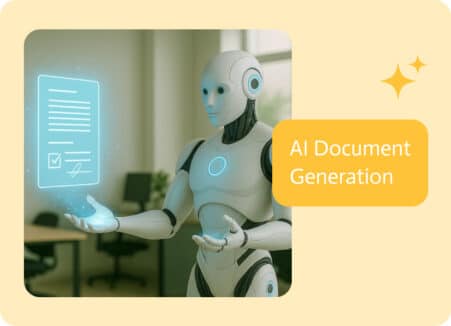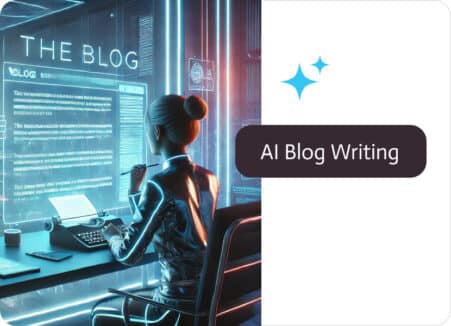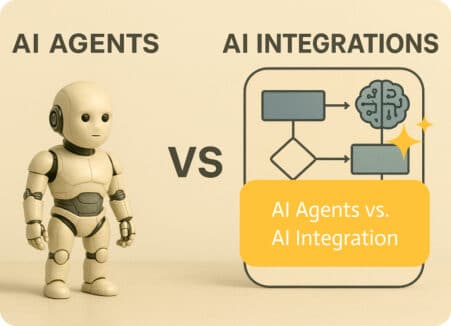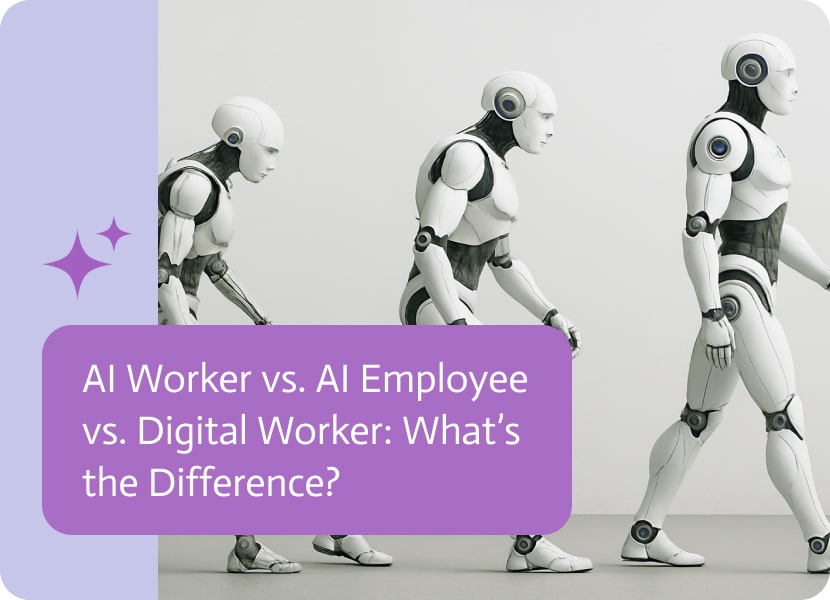
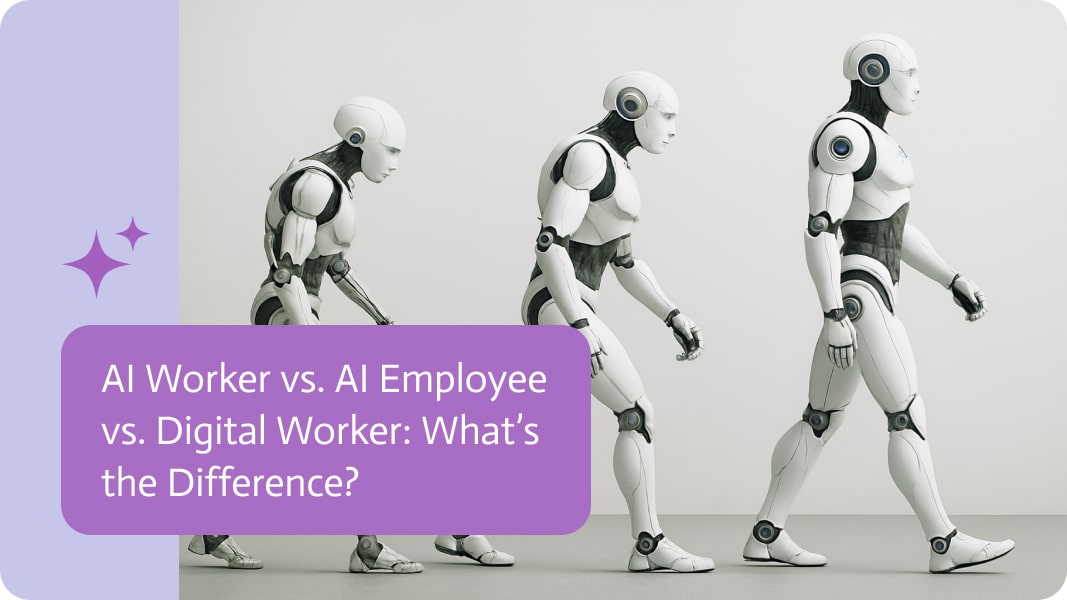
AI Worker vs. AI Employee vs. Digital Employee: What’s the Real Difference?
The modern office is buzzing with talk of digital colleagues. From automating boring jobs to orchestrating complex business outcomes, software is rapidly taking on roles once exclusively occupied by average people. But as this shift accelerates, a flurry of terms has entered our vocabulary: “digital worker,” “AI worker,” and “AI employee.”
Are these just fancy synonyms, or do they signify actual processes of automated enterprises?
If you’re trying to figure out business automation, the first step is about understanding what they mean exactly, it’s not just semantic nit-picking. It’s how you’ll make better decisions and ultimately build a truly efficient and future-proof operation. So, let’s pull back the curtain and uncover what differentiates these digital denizens of the modern office.
The Foundation: The Digital Worker
Imagine a seasoned office administrator who has spent years learning how to process invoices, update spreadsheets, and chase down approvals. Now imagine that knowledge distilled into a piece of software that can do those same tasks with unflappable consistency, twenty-four hours a day, seven days a week, without coffee breaks or any off-time. That, in essence, is a digital employee.
What Exactly Is a Digital Worker?
Simply put, a digital helper is a piece of software made to mimic and execute human-like interactions with business systems and applications. It’s basically a virtual team member that uses applications just like a person would. It clicks buttons, enters data, and moves through programs.
However, unlike a basic bot that handles one repetitive task, a digital employee is designed to take ownership of an entire workflow. Instead of just extracting data from a form, it can receive an order, validate customer details, check inventory, process payment, and notify shipping. In other words, it’s less about automating steps and more about automating processes.
The Tech Stack Behind It
The technologies underpinning a traditional digital worker often include:
- Robotic Process Automation (RPA): The workhorse of the digital worker world. If you can write the process down so a human can follow it, an RPA bot can probably be programmed to do the same thing.
- Basic Machine Learning and Natural Language Processing: These allow digital workers to handle semi-structured data (like forms with slight variations) and understand simple instructions or keywords.
- System Integrations: Connecting ERP, CRM, HR, and other platforms so the digital worker can string together an entire end-to-end process.
Their Benefits in Business
The number one goal of a digital worker is efficiency. They excel at high-volume, repetitive, rule-based tasks, like the assembly-line jobs of the digital world.
A digital worker is a highly skilled factory worker on a production line. They don’t redesign the assembly line or even come up with new products. They just keep things moving with machine-like consistency.
And that’s their power: they free us from the transactional grunt work so our focus can be put into creativity and problem-solving.
The Evolution: The AI Worker and AI Employee
Now, let’s take our tireless digital colleague and sprinkle in a dose of advanced intelligence. What if it could follow instructions to the T, but also grasp the intent that drives them? What if it could easily adjust to the unexpected, or continuously learn, and make judgments requiring human-like reasoning?
That’s where the AI worker digital employee enters the scene.
What’s Different About AI Workers?
If a digital worker is a factory line worker, an AI worker is the plant manager. It doesn’t just execute, it understands, troubleshoots, and optimizes.
Here’s how they step up the game:
- Unstructured Data: Unlike digital workers, who stumble outside neatly organized spreadsheets and forms, AI workers handle the usually jumbled business communications. Emails, contracts, chat logs, voice calls, and social media, they don’t just read words, they understand context.
- Non-Deterministic Workflows: Business isn’t always moving in a straight line. Processes diverge, exceptions pop up, and conditions change. AI workers grow in real time, altering things by using any new info they can gather.
- Cognitive Decision-Making: They don’t just follow instructions; they analyze, infer, and recommend. They are able to prioritize certain jobs, diagnose problems, and even forecast outcomes.
The Technology Powering Them
AI workers and AI employees rely on cutting-edge tech.
- Generative AI & LLMs: The brains of the operation, enabling language understanding, content generation, and communicating in a sophisticated way.
- Agentic AI: These can independently set goals, plan actions, execute them, and monitor progress, essentially managing an outcome from start to finish.
- Advanced ML & Deep Learning: Continuously learning and upgrading.
From Tasks to Whole Departments: What’s Next
Unlike digital workers, which are process-oriented, AI workers are role-oriented. Vendors don’t sell you “an AI that can extract invoices.” They sell you “an AI Finance Analyst” that monitors ledgers, reconciles accounts, and flags anomalies, if there are any. They’re digital colleagues with specialties, not just your average job-oriented bots.
Other examples:
- Sales Development Rep (SDR): Identifies prospects, drafts personalized outreach, follows up, and hands off qualified leads.
- Customer Service Agent: Reads nuanced customer messages, responds empathetically, resolves issues, and escalates only when it needs to.
What’s So Confusing?
So you’ve most likely seen these terms used interchangeably, and you’re not imagining it. There are two big reasons why the lines tend to blur slightly:
- Marketing Hype: Let’s face it, “AI Employee” sounds sexier than “automation bot.” Vendors want their products to sound more advanced, even when they’re still closer to digital workers.
- Evolving Tech: RPA platforms are adding AI capabilities. Platforms are building integrations. Suddenly, a “digital worker” equipped with LLM-powered NLP looks very similar to an AI worker
Why the Distinction
Executives, managers, and IT leaders care about whether they’re deploying a digital worker or an AI worker, because a mismatch often leads to disappointment.
- Put a digital worker to work when a job needs judgment, and it will fail.
- Put an AI worker on a repetitive, rule-based task, and you’ll be over-engineering (and overspending) on a problem that could have been solved with simpler automation.
It’s not only cost efficiency, it’s about strategy. Knowing what each can do helps organizations:
- Set realistic targets for automation.
- Invest wisely in technology.
- Redefine human roles, freeing people for strategic work.
- Scale intelligently, matching the right digital colleague to the right business need.
The Spectrum of Digital Workforces
The best way to think about it is as a spectrum, not rigid categories:
- Digital Worker (Foundational): “I will do what you instruct me to do, precisely and tirelessly.” Great for rule-based, structured workflows.
- AI Worker/AI Employee (Advanced): “I understand the goal, I’ll figure out how to achieve it, and I’ll adjust as things change.” Great for unstructured, complex, variable workflows.
Or, put another way:
- A coffee machine (Digital Worker) makes the same cappuccino when you press the button.
- An AI barista (AI worker) remembers your mood, suggests a seasonal blend, adapts the brew to the beans, and chats with you while it works.
Both make coffee, but the experience and intelligence involved are worlds apart.
Final Thoughts: An Intelligent Future
As we keep moving toward digital transformation, the workforce of the future will be a mix of people and digital intelligence.
The distinctions between a digital worker, an AI worker, and an AI employee help companies decide whether they need process execution or outcome management and whether they’re ready for rule-following automation or adaptive, cognitive collaboration.
We need to be moving beyond buzzwords and building an automation strategy that actually delivers. Whether it’s an army of diligent digital workers handling the transactional grind or a team of artificially intelligent employees tackling strategic challenges, the goal doesn’t change. We need to create more efficient, intelligent, and human-centric workplaces where digital colleagues don’t just follow orders, they bring ingenuity to the table.
The workplace of the future will be a place where people and digital employees work well together, each making the other stronger. The question isn’t whether you’ll work with them, but how soon you’ll be ready to welcome your first AI friend.
FAQs
1. Are digital helpers and AI helpers the same thing?
Not really. A digital helper is the more basic concept. AI helper/employee is the smarter version that changes with the flow.
2. Is “AI Teammate” just a marketing term?
Pretty much. It’s another way to say AI helper, but it makes it sound more like a digital colleague than a tool.
3. Can digital helpers handle stuff like emails that isn’t organized?
Newer ones can, but their comprehension is somewhat confined. AI helpers can handle this much better because they use advanced LLMs.
4. Do AI helpers replace human employees?
Not completely. They take over repeatable and well-defined jobs, but they usually work best with humans, asking for help when it gets complicated.
5. Should a business start with a digital helper or an AI helper?
It depends on how ready you are. If you’re just starting with automation, digital helpers are a good place to start. If you’re ready for something to manage whole roles, AI helpers make more sense.
